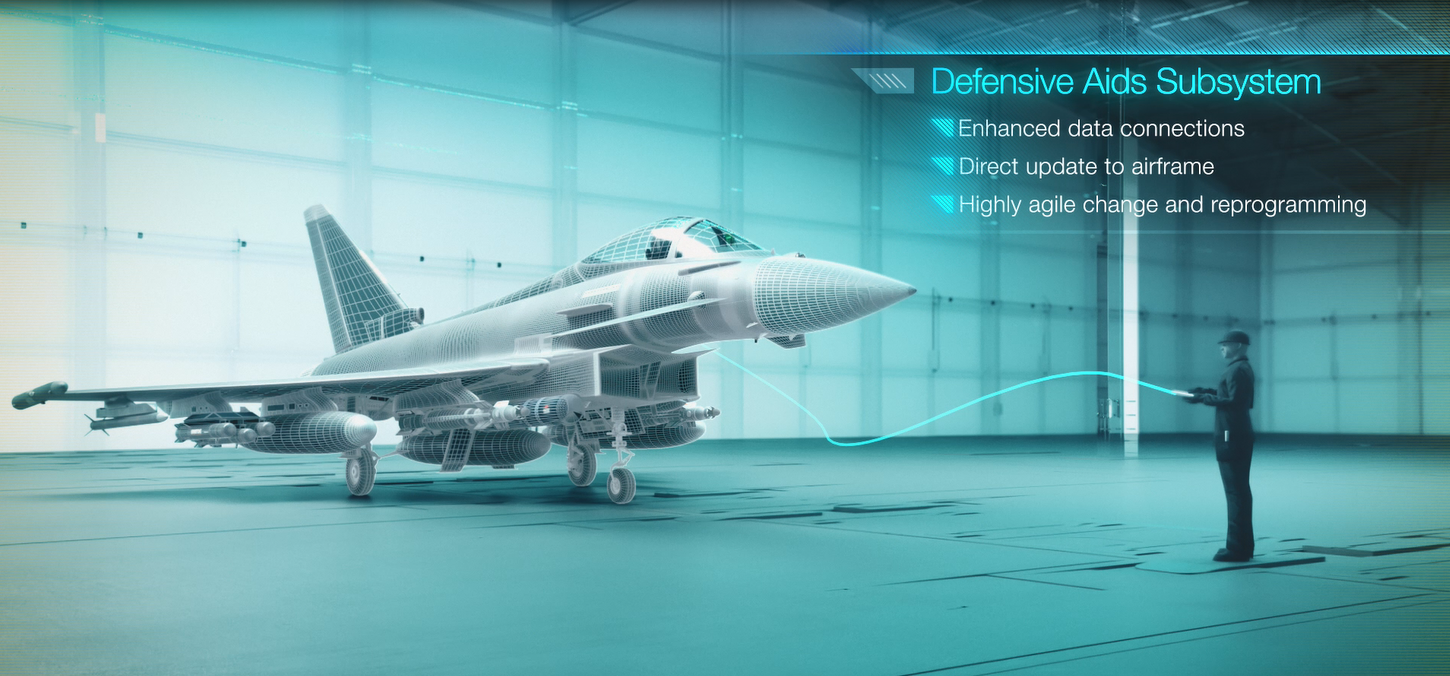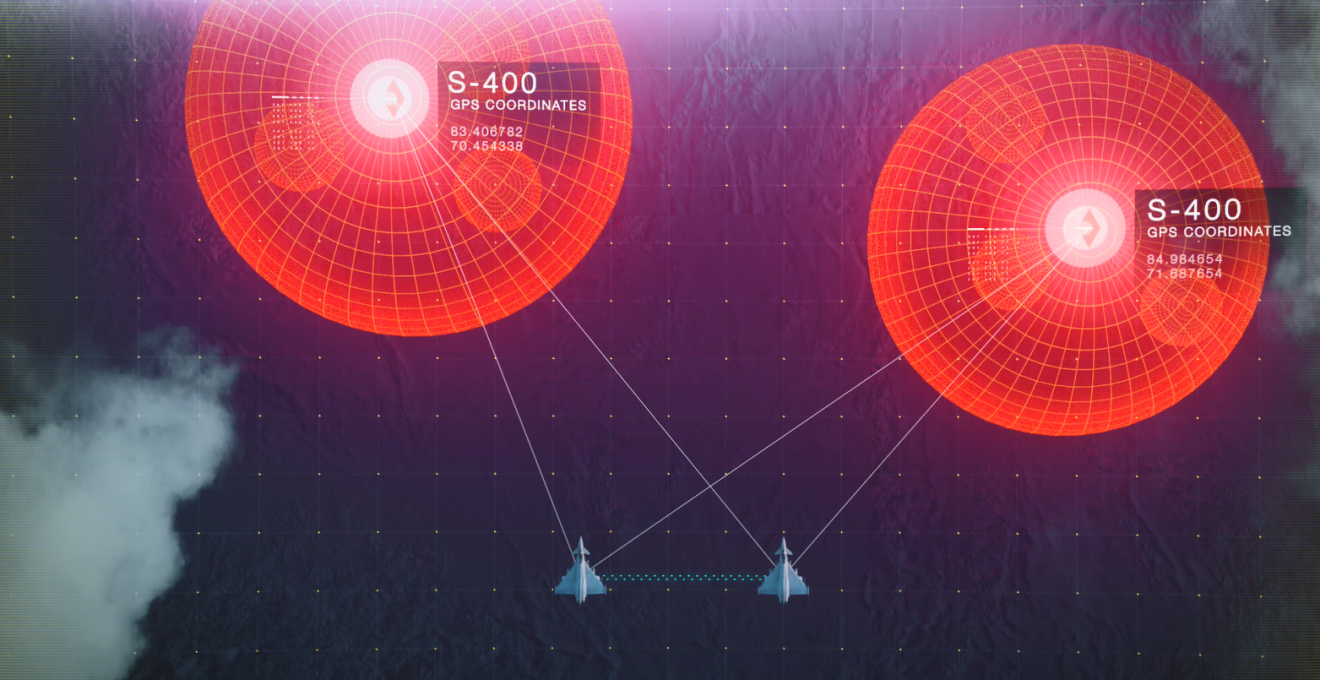Eurofighter Typhoon is equipped with one of the most capable Electronic Warfare (EW) systems installed on any combat aircraft. At its heart is the Typhoon’s Defensive Aids Sub System (DASS), known as Praetorian and provided by the EuroDASS consortium, a four nation group of EW experts comprising Leonardo in the UK, Elettronica in Italy, Indra in Spain and Hensoldt in Germany.
Praetorian protects Typhoon from threats including Infra-Red (IR or heat-seeking) and radar-guided missiles, while integrated sensors and jamming equipment also provide situational awareness and a digital stealth capability, achieved through advanced electronic deception techniques. The system has protected crews for over 20 years, including on peace-keeping operations in Libya and Syria.
However, we at EuroDASS recognise that as adversary technology and techniques rapidly evolve, the Typhoon’s traditional position of air dominance could be tested by advanced new air and surface threats.
This is why, over the last two years, EuroDASS has undertaken an assessment of the capability growth potential of the existing DASS system architecture. The conclusion drawn is that whilst there are short term enhancements that can maximise the capability growth of the existing system architecture, the continued evolution of the threat demands a corresponding evolution of the Praetorian DASS, embracing new technology to realise a new system architecture that will continue to provide exceptional survivability and keep Praetorian relevant through to the Out of Service Date (OSD) of Typhoon.
The Praetorian DASS, consists of the Electronic Surveillance Measures (ESM), Electronic Counter Measures (ECM) and Missile Approach Warner (MAW), providing platform survivability and Situational Awareness. Praetorian integrates with the remaining elements of the Typhoon Defensive Aids System (DAS), namely the Defensive Aids Computer (DAC) and the Chaff and Flare Counter Measures Dispensing System (CMDS).
Fitting the defensive suite to the role requirement
Recognising both the budgetary constraints faced by nations, and their numerous priorities, EuroDASS have considered how best to maximise the Typhoon’s defensive capability across future fleets. At the simplistic level, it may be the case that not every Typhoon being operated will need the most comprehensive DASS system installed, depending upon the role being fulfilled. This has led to a pragmatic approach based upon our interpretation of future role requirements; from a predominantly defensive role (for example Quick Reaction Alert, QRA) to an overtly peer-on-peer offensive role. The corresponding standard or capability of DASS has then been considered against this.
A rational approach is to assume a sub-set of the future fleet mix will maintain the current DASS system architecture, maximised for capability growth to address the more defensive spectrum of operations and role requirements. A further sub-set will require a new DASS system architecture, capable of countering and defeating the evolving threat and staying relevant with capability growth potential to the OSD of Typhoon.
A new architecture for the future battlespace
Looking towards the future, we first must consider the future threat environment. Maintaining control of the Electro-Magnetic (EM) Spectrum is fundamental for Nations to achieve freedom of movement, access and control of the air. The threat environment is becoming increasingly complex, congested and contested. The threat continues to evolve at a pace, with increasingly complex emitters and agile software adaption, coupled with increased availability and proliferation of long range, mobile and networked surface threats. Opposition air platforms are also being equipped with advanced Digital Radio Frequency Memory (DRFM) capabilities. This all means that unless the DASS continues to outpace the evolution of the threat, nations risk losing the essential elements of control of the air.
Inevitably, in some areas of the current DASS, the physical constraints imposed by the system architecture are resulting in the capability approaching its maximum potential, meaning that a new architecture is necessary to continue to achieve the air dominance Typhoon is accustomed too. .

EuroDASS has, whilst being cognisant of the future challenges imposed by the future operating environment, considered the future of Praetorian on Typhoon. Resulting from this work are the fundamentals for a future DASS architecture that will continue to provide world-class survivability for Typhoon and also contribute to the role evolution of the platform.
Praetorian Evolution represents this new system architecture, and addresses four key operational capability themes:
1 Capability Availability
Operational capability is only relevant if it is available when required. At our recent EuroDASS Future Capability Conference (October 2019) this was effectively articulated as ‘Little C’ and ‘Big C’. ‘Little C’ being the underpinning availability, serviceability and maintainability that makes the ‘Big C’ available and deployable when needed.
Praetorian Evolution will have a maximal digital architecture, exploiting high-rel manufacturing techniques to improve equipment reliability. The digital architecture also supports enhanced health monitoring, offering improved fault diagnosis and reduced no-fault-found scenarios, both contributing to reduced repair turn-around-times.
The Evo architecture will comprise of common hardware modules, configured by software, thus reducing through life cost of ownership by reducing the requirement for spares holdings.
2 Weapon System Integration
A multi-channel digital receiver architecture will provide high quality, high fidelity parametric data. This capability will allow Typhoon to act as a forward combat ISR-node, providing forward intelligence gathering opportunities and contributing to the wider digital battlespace picture and shared situational awareness via data off-boarding.
The enhanced processing will also allow the DASS to contribute to sensor correlation and confirmation.
Clearly, interoperability across the weapon system, own-ship and multi-ship will increase in complexity as the number of on-board emitters increase and exhibit increased bandwidth and/or power. The Evo architecture will provide additional interfaces (ethernet and discrete) to interface to other subsystems to facilitate improved interoperability.
3 High Frequency Agile Change
Agility and adaptability will be a key discriminator in the future dynamic battlespace. Legacy threats are Evolving, and exhibiting agile update cycles; modern threats are quickly and easily reprogrammed. In response the future DASS must support agile update and migrate from traditional mission data constructs to a more intelligent algorithmic based mission data construct. The traditional approach of parametric-based mission data fields is becoming insufficient to cover all modes of threat variants and unable to resolve threat system ambiguities. Furthermore, we must strive to reduce the complexity and burden placed upon National Air Warfare centres for the creation of mission data.
The Evo architecture will provide a segregated software architecture that supports the safe introduction of applications and algorithmic mission data. This will support threat-specific ECM applications, and ESM analytical algorithms providing threat identification, situational awareness and optimised countermeasures. The segregated architecture will also support the longer term aspiration to move certain elements of operational functionality from the operational software to algorithmic mission data, meaning functional update can be achieved in a far more agile and cost effective manner.
4 Operational Capability
In terms of the future capability requirements for the DASS, in generic terms these address themes such as extension to the operational frequency ranges; effective operation in the future congested and contested EM environment; networked multi-platform co-operative techniques; enhanced ECM in terms of field of view, power and technique complexity; geolocation and unambiguous emitter identification; low false alarm rate missile warning. These have shaped the Praetorian Evolution architecture, alongside the future growth potential to support incremental capability growth by software update through to the Typhoon’s OSD.
New technology underpinning future capabilities
The exploitation of latest technology and manufacturing techniques is fundamental to realising the capabilities and benefits of Praetorian Evolution. New technology will realise advancements in orders of magnitude in data processing, integration and bandwidth over the existing architecture.

Advances in ultra-fast sampling and digitisation will enable wide bandwidth digitisation, effectively behind the receive antenna.
System-on-Chip (SoC) technology combines hardware (analog, digital, mixed-signal, Radio Frequency (RF) functions) and software processing into a single integrated chip. This high level of integration uses less power, and offers significant SWaP (size weight and power) benefits.
Novel antenna design techniques will mean traditionally large physical antenna designs can be realised in smaller, more integration friendly adaptations formats.
Across the EuroDASS consortium, each partner company is already investing in maturation of these technology enablers, increasing the respective Technology Readiness Level (TRL) and realising mature building blocks for the future architecture.
The recently-contracted Long Term Evolution Study provides a timely opportunity for the Eurofighter partner companies and EuroDASS to collectively mature the work already undertaken. A number of studies are currently underway, exploring the technology enablers to support a range of future architectures which will be presented to nations. These will have an associated capability trade-off thus helping nations assess the trade space between operational capability, wider platform impact, risk maturity and cost.
In summary, while Typhoon remains one of the best-protected platforms flying today, EuroDASS recognise the future challenges and are working hard to make sure Typhoon stays a step ahead over the decades to come. In the short term, mature candidate solutions are available to maximise the capability of the existing system architecture, providing longevity to the current Praetorian for defensive roles.
